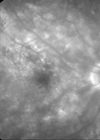Photoessay
A patient report of pseudoxanthoma elasticum, angioid streaks and choroidal neovascularisation
Angioid streaks (AS) on their own do not cause many problems, with the majority of patients remaining asymptomatic [1]. However, once choroidal neovascularisation (CNV) occurs, the visual prognosis of the patient rapidly declines [2]. Treatment is imperative to try and...
Acute retinal necrosis presumably caused by Epstein-Barr virus infection
Acute retinal necrosis (ARN) is an uncommon, but serious and potentially blinding condition. ARN is characterised by panuveitis, occlusive vasculopathy and progressive peripheral necrotising retinitis. The diagnosis is clinical but confirmation is sought via aqueous and vitreous sampling. Varicella zoster...
An unusual case of acute retinal necrosis
Case report A 40-year-old Caucasian male presented with a four-day history of redness and progressive painless reduction of vision in the left eye. His visual acuities were 6/4 in the right and 6/36 in the left. The left eye showed...
Severe conjunctival cicatrisation secondary to chronic glaucoma therapy
The timing of glaucoma filteration surgery during the course of chronic progressive glaucoma remains a contentious issue amongst glaucoma specialists. The vast majority support the use of maximal medical treatment initially to achieve the target pressure. Surgical procedures are only...
Melanocytoma of the optic disc
Melanocytoma is a heavily pigmented lesion, composed of melanocytes and is a variant of melanocytic naevus. It classically occurs at the optic disc and is usually benign, static and asymptomatic. However, it can occasionally grow and invade the retina or...
A single intravitreal bevacizumab in the treatment of breast carcinoma related choroidal metastasis
Case report Choroidal metastasis represents a common form of intraocular malignancies occurring in up to 10% of patients with systemic metastasis [1]. The most common primary sites of ocular metastasis are breast carcinoma in women and lung carcinoma in men,...
Birdshot chorioretinopathy: an important differential
Birdshot chorioretinopathy (BSCR) is a relatively uncommon cause of posterior uveitis which often has a relapsing and remitting course [1,2]. We present a case which demonstrates how remission can be obtained for several years using cyclosporine. Case report A 44-year-old...
Cytomegalovirus retinitis post intravitreal triamcinolone in an immunocompetent patient with juvenile glaucoma
Figure 1: Fundus photograph shows active CMV retinitis four weeks after IVTA in the right eye. Figure 2: Fundus photograph of the left eye with no CMV retinitis; atrophic disc as a result of juvenile glaucoma. Case report A 29-year-old...
An uncommon late postoperative complication of combined cataract surgery and intravitreal triamcinolone injection
Case report A 64-year-old female with diabetic maculopathy (DMO) underwent phacoemulsification with intraocular lens (IOL) implantation in her right eye combined with intravitreal triamcinolone (IVTA). Diabetes control was poor with HbA1c (IFCC) of 119mmol/mol and blood sugar level of 27mmol/L....
Blurred vision post liver transplant: to blame the house cat or not?
This article outlines a case of atypical ocular toxoplasmosis associated with immunosuppression. There were two potential sources of infection in this patient and we describe how we concluded which was the most likely. Case report A 33-year-old female was referred...
Choroidal folds
Choroidal folds are undulations of the choroid, Bruch’s membrane and pigment epithelium, with wrinkling of the overlying retina. They may be idiopathic but can also be caused by a number of different conditions. Case report A 60-year-old male patient was...
Cortical blindness
Cortical blindness is a rare but recognised entity. Cerebrovascular accident is a well-known risk factor. We report a case of an 84-year-old lady with bilateral cortical blindness with multiple cardiovascular risk factors. Case report An 84-year-old lady was admitted under...
















